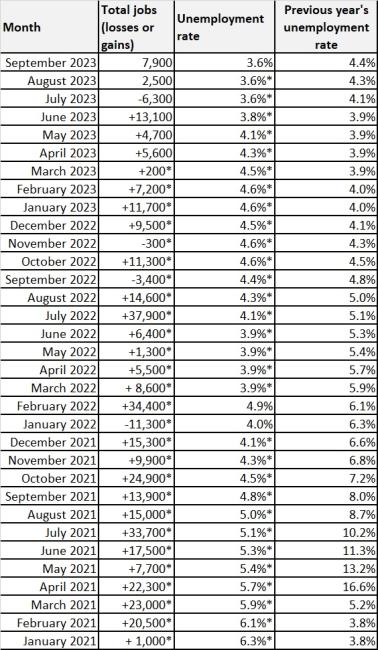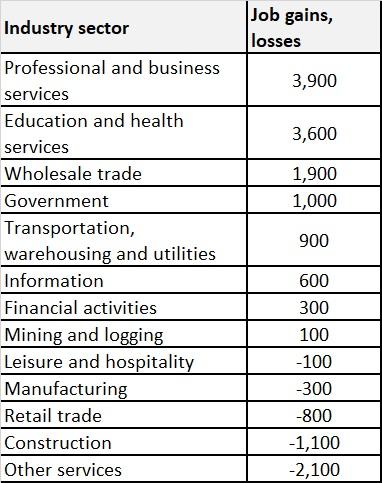Released on
FOR IMMEDIATE RELEASE
Contact: media@esd.wa.gov
OLYMPIA – Washington’s economy gained an estimated 7,900 jobs (seasonally adjusted) and the monthly unemployment rate remained constant at 3.6% in September.
Payroll employment grows in September; unemployment rate holds steady
"Jobs grew at a faster pace than the prior month,' said Employment Security Department (ESD) State Economist Paul Turek. "The demand for workers has been resilient, although the trend toward more modest job growth remains intact.'
Visit ESD’s website to view the entire Monthly Employment Report for September.
ESD paid unemployment insurance benefits to 54,073 people in September, a decrease of 2,862 paid claims over the previous month. Decreases in paid claims within transportation and warehousing, and the health care and social assistance sectors contributed to the overall decrease in claims over the month.
Updated state preliminary data for August 2023
- The preliminary estimated gain of 2,900 jobs in August was revised to a gain of 2,500 jobs.
- The seasonally adjusted monthly unemployment rate in August was confirmed at 3.6%.
National unemployment rate
The national unemployment rate remained constant at 3.8% in September. For comparison, the national unemployment rate (revised) for September 2022 was 3.5%.
Labor force showed little change
The state’s labor force in September numbered 4,061,200 – a decrease of 6,000 people from the previous month.
In the Seattle/Bellevue/Everett region, the labor force decreased by 400 over the same period.
Labor force is defined as the total number of people, both employed and unemployed, over the age of 16. Layoffs and labor force participation are not necessarily connected. When people are laid off but still seeking work, they remain a part of the labor force. A drop in the labor force means people have left work and haven't been actively seeking employment for more than four weeks.
From September 2022 to September 2023, the state’s labor force increased by 53,700, while the labor force in the Seattle/Bellevue/Everett region increased by 42,200 over the same period.
From August to September 2023, the number of people who were unemployed statewide increased from 145,900 to 146,900. In the Seattle/Bellevue/Everett region, the number of people who were unemployed increased from 57,800 to 59,200 over the same period.
A majority of major industries added jobs
Private sector employment increased by 6,900 jobs from August to September while government employment increased by 1,000 jobs.
Of the industry sectors, in September:
- Eight expanded.
- Five contracted.
Here are some key increases and decreases:
- Professional and business services employment increased by 3,900, with 2,100 jobs added in administrative and support services.
- The number of jobs in education and health increased by 3,600, with 1,000 jobs gained in nursing and residential care facilities.
- Retail trade employment decreased by 800 overall, with 1,000 jobs lost in food and beverage stores.
- Construction employment fell by 1,100, with 1,000 jobs lost by specialty trade contactors.
- Employment in other services decreased by 2,100 overall, with 2,300 jobs lost in personal and laundry services.
Annual employment growth most evident in education and health services
Washington gained an estimated 55,300 jobs from September 2022 to September 2023, not seasonally adjusted. Private sector employment rose by 1.5%, up an estimated 45,200 jobs, while public sector employment rose by 1.8% — up an estimated 10,100 jobs.
From September 2022 – September 2023, nine major industry sectors expanded and four decreased
The three industry sectors with the largest employment gains year over year, not seasonally adjusted, were:
- Education and health services, up 22,400 jobs.
- Leisure and hospitality, up 17,800 jobs.
- Government, up 10,100 jobs.
The three industry sectors with the largest employment losses year over year, not seasonally adjusted, were:
- Information, down 5,900 jobs.
- Retail trade, down 3,200 jobs.
- Professional and business services, down 1,400 jobs
Table 1: Washington’s total jobs

*Revised from previous preliminary estimates. Preliminary monthly estimates for job losses or gains are
based on a small Bureau of Labor Statistics payroll survey. Actual figures reported the following month
are based on a more complete survey.
Table 2: Job gains and losses by industry for September

Labor market information
See more labor market information and tools, including interactive Tableau graphics, to highlight popular information and data.
WorkSource
Employment Security is a proud partner in the statewide WorkSource system, which provides employment and training assistance to job seekers and businesses. WorkSourceWA provides access to thousands of Washington jobs and other employment resources. WorkSource staff can connect job seekers with employers hiring right now in their community, identify training opportunities or help them brush up on application and interview skills. Job seekers and employers can find their nearest WorkSource center on the WorkSource office locator page.
Learn more about ESD’s monthly employment reports
Every month, the Employment Security Department publishes preliminary seasonally adjusted estimates for the prior month’s job growth and unemployment. We also publish confirmed data for the month before last. See the entire Monthly Employment Report on our website.
Monthly Employment Report publication schedule for 2023
|
Preliminary data for the month |
State and Metropolitan Division data release |
All other county data released |
|---|---|---|
|
September |
Oct. 18, 2023 |
Oct. 24, 2023 |
|
October |
Nov. 15, 2023 |
Nov. 21, 2023 |
|
November |
Dec. 20, 2023 |
Dec. 26, 2023 |
|
December |
Jan. 17, 2024 |
Jan. 23, 2024 |
U-6 unemployment rate
The U.S. Bureau of Labor Statistics (BLS) updated its 'alternative measures of labor underutilization' for states to include annual averages for 2021. One such alternative measure is the U-6 rate, which considers not only the unemployed population in the official 'U-3' unemployment rate, but also marginally attached workers and those employed part time for economic reasons. The U-6 rate is defined by BLS as the 'total unemployed, plus all marginally attached workers, plus total employed part time for economic reasons, as a percent of the civilian labor force plus all marginally attached workers.' This U-6 measure measures the 'unemployed, underemployed, and those who are not looking but who want a job.'
The U-6 annual average unemployment rate for the four-quarter period through second quarter 2023 for Washington state was 7.3 percent. This was lower compared to the 7.4 percent average for the four-quarter period through first quarter 2023. The U.S. U-6 average for the four-quarter period through second quarter 2023 was 6.7 percent.

